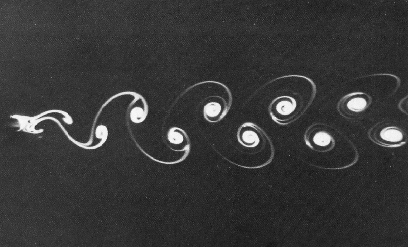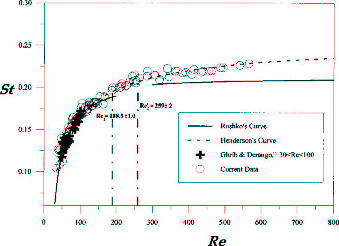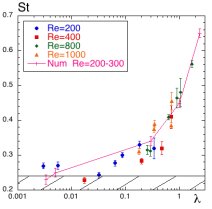Summary
Experimental results
Numerical results
Stability analysis of experimental wakes
Stability analysis of jets, shear and wakes
Several coherent structures encoutered in
the oceans or in the atmosphere of giant planets have characteristic
scales larger than the local deformation radius. The latter is an
intrinsic scale that controls the dynamics of rotating and stratified
flows. The deformation radius depends on the vertical structure of the
flows and may vary from a few tens of kilometers in the ocean to a few
thousand of kilometers in the Earth's atmosphere or in that of giant
planets. Large-scale flows correspond to a wide variety of geophysical
flows having their characteristic scale larger than the local
deformation radius. In such cases, an asymmetry is often observed in
the dynamics and in the morphology of cyclonic and anticyclonic
structures. For instance, the famous long-lived eddies formed in the
zonal circulation of outer planets such as the Great Red Spot or White
Oval of Jupiter are anticyclones, whereas cyclones are generally
smaller and more elongated. In the Earth's ocean, large-scale eddies
such as submesoscale coherent vortex, meddies and swoddies are mostly
anticyclonic. The predominance of anticyclones has been observed in
simple models, such as rotating shallow water model in the f-plane. As far as shallow-water
decaying turbulence is concerned the departure from quasi-geostrophy
leads to a significant asymmetry for which anticyclonic vortices are
more circular and robust than cyclones. Stability analysis of isolated
vortices show that anticyclones are more stable than cyclones as soon
as the scale of vortices become large than the deformation radius.
However, this large-scale
asymmetry was never studied for a Karman wake. In such a case, both
global (the wake) and local (the vortices) structures could be
affected. Hence, the objective of this study is to determine how a
cyclone-anticyclone asymmetry could affect the dynamics of large-scale
wakes.
In a classical non
rotating two-dimensionnal flow, the dynamics of the wake is controled
by a single parameter: the Reynolds number which represents the
importance of viscous effects. For Reynolds number larger than a
critical value, Re~48, the boundary layers
formed on the obstacle detach and roll-up alternatively on each side of
the cylinder leading to a
classical von Karman street. The vortex street is characterised by the
shedding frequency of the vortices, called the Strouhal number when non
dimensionalised. The Strouhal number is an intrinsic parameter of the
flow, it grows with the Reynolds number and tend ansymptotically to a
constant value about 0.2 (Fig. 1).


As far as numerical
simulations are concerned, shallow-water equations have been integrated
with a pseudo-spectral code. The obstalce was represented with a
penalisation method. This method considers the whole domain, fluid and
solid, as a same porous media whose porosity could vary in space and
time. As the penalisation method has never been used with a free
surface model, numerical simulations are compared with laboratory
experiments.
Laboratory experiments
have been performed in a rotating tank with a two layers stratified
fluid, the bottom layer being thick and dense and the upper one shallow
and light. A cylinder is translated only in the upper layer.
Thanks to a small depth aspect ratio between the upper and the bottom
layer, we can reasonnably neglect the dynamics in the bottom layer and
consider the dynamics of one shallow layer with a free surface.
In a frontal
regime, the structure of large-scale wakes is totally different from
the classical von Karman streets observed generally in the wake of a
cylinder. This particular structure of the wakes has been observed in
both numerical simulations and laboratory experiments. When the surface
deviation increases,
a strong cyclone-anticyclone asymmetry appears, anticyclones are
circular whereas cyclones are stretched and deformed. For a specific
range of parameters, only anticyclones are formed in the wake. Besides,
vortices are not shedded from the obstacle like in the classical von
Karman wake, but instead, two parallel shear layers separate from the
cylinder, extend up to several diameters behind the cylinder and only
anticyclonic vortices roll up far dwonstream in the wake. Moreover, the
Strouhal number reaches values three times larger than the standard
value reached for the same Reynolds number in a classical Karman
street. The variation of the Strouhal number is governed by a single
parameter, the relative interface deviation (Fig. 2). The resulting
flow pattern ressembles more that of a mixing layer than a von Karman
street.


Fig. 2. Vorticity field
obtained by numerical simulations performed in a frontal regime (
cyclones are in red and anticyclones in blue). Evolution of the
Strouhal number (numerical simulations and laboratory experiments) as a
function of the relative surface deviation.
In order to determinate the mechanisms
responsible for the cyclone-anticyclone asymmetry in the vortex street
and the nature of the instability, we performed a local stability
analysis of parallel experimental wakes. In the frontal regime
(i.e. large geopotential deviations) the linear stability induces a
selective destabilization of anticyclonic vorticity region. Indeed, in
this regime, the most unstable mode is always localized in the
anticyclonic shear region. Full nonlinear simulations show that
cyclonic vortices are stretched and strongly deformed, in a frontal
regime, in comparison with the anticyclonic vortices which remain
robust and more circular. We recover with a local analysis the vortex
street pattern observed experimentally in the frontal regime with a
comparable Strouhal number. This indicate a change in the nature of the
wake instability when the geopotential fluctuations become large
enough. This change is confirmed by the spatio-temporal analysis
of the asymmetric wake in a frontal regime. In this case, we found that
the wake flow measured behind the cylinder is convectively unnstable. A
small wavepacket perturbation propagates downstream in the flow but
does not contaminate the entire flow as it is the case for the
classical 2D von Karman wake. Hence, this shows a transition in the
nature of geophysical wake instability in rotating shallow water
flows when the frontal regime is reached.
We have shown that the wake instability,
in a frontal regime, favours the production of anticyclones. In order
to determine whether horizontal shear instability is a general
mechanism for the production of anticyclonic vortices, we extend the
stability analysis to various flows : jets, localized shear and wakes.
On the one hand, the frontal regime strongly stabilizes jet flows but
no cyclone-anticyclone asymmetry occurs in the linear phase. On the
other hand, the stability property of cyclonic and anticyclonic shear
is different in a frontal regime. The anticyclonic shear is much more
unstable than the cyclonic one and lead more rapidly to the formation
of anticyclones. Yet, according to the nonlinear evolution of perturbed
shear flows, both cyclonic and anticyclonic localised shear lead to the
formation of axisymmetric vortices at the end. In the case of wake
flows where cyclonic and anticyclonic shear are correlated, the most
unstable mode is localised in the anticyclonic shear zone only.
Therefore, anticyclones are formed first and create a strain that
stretches the cyclonic shear. When cyclones appear, they are deformed
and the wake present a strong cyclone-anticyclone asymmetry. Therefore,
barotropic instability of parallel shear flows, in a frontal regime,
favours the production of strong circular anticyclones. This mechanism
may be a cause of the predominance of large-scale anticyclones in the
ocean.
Moreover, the predominance
and the robustess of anticyclones may have an important impact on
mixing and transport of passive tracers such that phytoplancto or
polluting agents shedded along the coasts.

